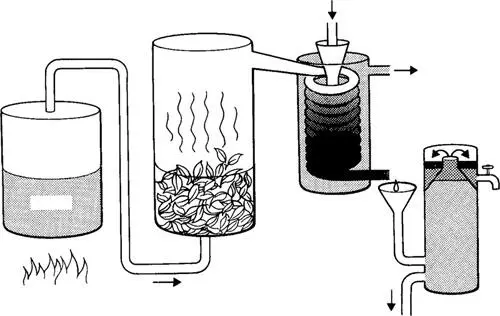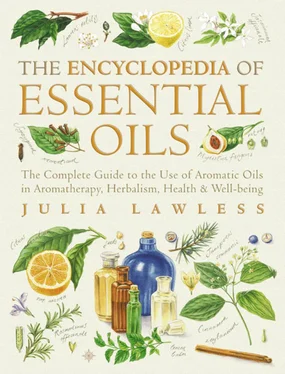1 ...8 9 10 12 13 14 ...23
6. A GUIDE TO AROMATIC MATERIALS
Habitat
Over thirty families of plants, with some ninety species, represent the main oil-producing group. The majority of spices (allspice, cardamon, clove, nutmeg, ginger, etc.) originate in tropical countries; conversely, the majority of herbs grow in temperate climates (bay, cumin, dill, marjoram, fennel, lavender, rosemary, thyme, etc.). The same plant grown in a different region and under different conditions can produce essential oils of widely diverse characteristics, which are known as ‘chemotypes’. Common thyme ( Thymus vulgaris ), for example, produces several chemotypes depending on the conditions of its growth and dominant constituent, notably the citral or linalol types, the thuyanol type, and the thymol or carvacrol type. It is therefore important not only to know the botanical name of the plant from which an oil has been produced, but also its place of origin and main constituents. One of the main ways of defining the qualities of a particular oil and checking its purity is to ascertain the specific blend of/components and look at its chemical character.
In general, essential oils consist of chemical compounds which have hydrogen, carbon and oxygen as their building blocks. These can be subdivided into two groups: the hydrocarbons which are made up almost exclusively of terpenes (monoterpenes, sesquiterpenes and diterpenes); and the oxygenated compounds, mainly esters, aldehydes, ketones, alcohols, phenols and oxides; acids, lactones, sulphur and nitrogen compounds are sometimes also present.
Common terpene hydrocarbons include limonene (antiviral, found in 90 per cent of citrus oils) and pinene (antiseptic, found in high proportions in pine and turpentine oils); also camphene, cadinene, caryophyllene, cedrene, dipentene, phellandrene, terpinene, sabinene, and myrcene among others. Some sesquiterpenes, such as chamazulene and farnesol (both found in chamomile oil), have been the object of great interest recently due to their outstanding anti-inflammatory and bactericidal properties.
Probably the most widespread group found in essential oils, which includes linalyl acetate (found in bergamot, clary sage and lavender), and geranyl acetate (found in sweet marjoram). They are characteristically fungicidal and sedative, often having a fruity aroma. Other esters include bornyl acetate, eugenyl acetate and lavendulyl acetate.
Citral, citronellal and neral are important aldehydes found notably in lemon-scented oils such as melissa, lemongrass, lemon verbena, lemon-scented eucalyptus, citronella etc. Aldehydes in general have a sedative effect; citral has been found to have specifically antiseptic properties. Other aldehydes include benzaldehyde, cinnamic aldehyde, cuminic aldehyde and perill aldehyde.
Some of the most common toxic constituents are ketones, such as thujone found in mugwort, tansy, sage and wormwood; and pulegone found in pennyroyal and buchu – but this does not mean that all ketones are dangerous. Non-toxic ketones include jasmone found in jasmine, and fenchone in fennel oil. Generally considered to ease congestion and aid the flow of mucus, ketones are often found in plants which are used for upper respiratory complaints, such as hyssop and sage. Other ketones include camphor, carvone, menthane, methyl nonyl ketone and pinocamphone.
One of the most useful groups of compounds, tending to have good antiseptic and antiviral properties with an uplifting quality; they are also generally non-toxic. Some of the most common terpene alcohols include linalol (found in rosewood, linaloe and lavender), citronellol (found in rose, lemon eucalyptus and geranium) and geraniol (found in palmarosa); also borneol, menthol, nerol, terpineol, farnesol, vetiverol, benzyl alcohol and cedrol among others.
These tend to have a bactericidal and strongly stimulating effect, but can be skin irritants. Common phenols include eugenol (found in clove and West Indian bay), thymol (found in thyme), carvacrol (found in oregano and savory); also methyl eugenol, methyl chavicol, anethole, safrole, myristicin and apiol among others.
By far the most important oxide is cineol (or eucalyptol) which stands virtually in a class of its own. It has an expectorant effect, well known as the principal constituent of eucalyptus oil. It is also found in a wide range of other oils, especially those of a camphoraceous nature such as rosemary, laurel, tea tree and cajeput. Other oxides include linalol oxide found in hyssop (decumbent variety), ascaridol, bisabolol oxide and bisabolone oxide.
In general, the term ‘essential oil’ is rather loosely applied to all aromatic products or extracts derived from natural sources, including concretes, resinoids and absolutes which contain a mixture of volatile and non-volatile components, such as wax or resin. This is not strictly accurate, since they are only partially composed of essential oils and are obtained by different methods of production, which include the use of solvents or more recently, carbon dioxide extraction. However, it is always the essential oil content in a given product that accounts for its aromatic quality.
Some plant materials, especially flowers, are subject to deterioration and should be processed as soon as possible after harvesting; others, including seeds and roots, are either stored or transported for extraction, often to Europe or America. The method of extraction which is employed depends on the quality of the material which is being used, and the type of aromatic product that is required.
An essential oil is extracted from the plant material by two main methods: by simple expression or pressure, as is the case with most of the citrus oils including lemon and bergamot, or by steam, water or dry distillation. The majority of oils such as lavender, myrrh, sandalwood and cinnamon are produced by steam distillation. This process only isolates the volatile and water-insoluble parts of a plant – any other (often valuable) constituents, such as tannins, mucilage and bitters, are consequently excluded from the essential oil. Sometimes the resulting oil is redistilled or rectified to get rid of any remaining non-volatile matter; some essential oils are redistilled at different temperatures to obtain certain constituents and exclude others – as with camphor which is split into three fractions, white, yellow and brown.

The process of steam distillation as it is practised today
Essential oils are usually liquid, but can also be solid (orris) or semi-solid according to temperature (rose). They dissolve in pure alcohol, fats and oils but not in water and, unlike the so-called ‘fixed’ plant oils (such as olive oil), they evaporate when exposed to air leaving no oily residue behind.
Concretes are prepared almost exclusively from raw materials of vegetable origin, such as the bark, flower, leaf, herb or root. The aromatic plant material is subjected to extraction by hydrocarbon-type solvents, rather than distillation or expression. This is necessary when the essential oil is adversely affected by hot water and steam, as is the case with jasmine; it also produces a more trueto-nature fragrance. Some plants, such as lavender and clary sage, are either steam distilled to produce an essential oil or used to produce a concrete by solvent extraction. The remaining residue is usually solid and of a waxy non-crystalline consistency.
Читать дальше













